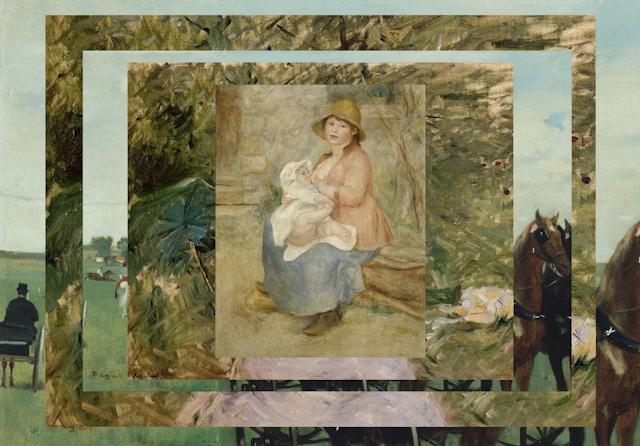The history of breastfeeding reveals uncomfortable truths about women, work and money. An unlikely place where the history of nursing is clearly visible is in Impressionist paintings.
Although the art of Manet and his followers is best known for its sunny landscapes and scenes of Parisian leisure, many of these paintings tell complicated human stories. Pierre-Auguste Renoir, Edgar Degas and Berthe Morisot depict breastfeeding as the perfect example of women’s invisible labour.
In the 19th century, wet-nursing – where women were paid to nurse someone else’s child – was widely practised in Europe.
Wet-nursing is an age-old practice, but in 19th-century Paris, as more women went to work in Georges-Eugène Haussmann’s newly designed modern city, it was a booming industry. Rural wet nurses (ideally in their 20s, in good health, with strong teeth, and thick white milk) were regularly employed to nurse the children of both urban lower- and middle-class women and were one of the most prized domestic servants in the bourgeois home.
However, following French chemist Louis Pasteur’s scientific discoveries of how bacteria spread, as well as medical publications promoting the health-giving benefits of a mother’s milk, maternal nursing began to be favoured over wet nursing. Also, conservative Catholic and liberal political ideologies fused to encourage breastfeeding as central to modern womanhood.
Breastfeeding was not a common theme in Impressionism but its treatment by Degas, Renoir and Morisot gives a fascinating insight into some of the ways women who practised it were perceived.
1. At the Races in the Countryside by Edgar Degas (1869)

In At the Races in the Countryside (1869) we see a wealthy family, the picture of modern success, in a fancy carriage. The mother and the wet nurse (identified through her outfit and exposed breast) are seated together while the sharply dressed father, and the bulldog (an image of modern domesticity) both gaze directly at the baby and breast.
As art critic Gal Ventura notes in her encyclopaedic study of breastfeeding in art, there are links here with sexuality that draw connections between the wet nurse and the prostitute, a figure Degas often depicted. Both were working women who sold their bodies, or rather their bodily functions, for profit to wealthy families. Although the wet nurse was closer to Madonna than a whore.
What Degas highlights here – via the convergence of the male gaze, the female body at work and the theme of urban leisure – is the pervasive presence of modern capitalism and exchange even within a painting that takes leisure as its ostensible focus.
2. Maternity by Pierre-Auguste Renoir (1885)
The shift towards maternal nursing is seen in a series of works Renoir made in the 1880s of his future wife Aline nursing their first-born son, Pierre. Aline was a seamstress from the countryside and so seeing her breastfeed was less shocking to an uptight bourgeois audience.

In the first of this series called Maternity, Renoir shows Aline sitting on a fallen tree, very much looking like a peasant with a ruddy face in her straw hat and dowdy clothes. She is also sexualised through her plump, protruding breast and direct gaze.
Breasts, Ventura writes, “are a scandal for the patriarchy because they disrupt the border between motherhood and sexuality”.
Aline seems blissful, as does Pierre, but there is something off. Renoir’s association of his breastfeeding spouse with the natural world is troublesome. The depiction echoes the claim made by the feminist Simone de Beauvoir in The Second Sex about how under the patriarchy, through a woman’s ability to breastfeeding and become a mother, “a woman is only a female domesticated animal”. Her serene nature also suggests that breastfeeding is not a strain or “work”.
The Wet Nurse Angèle feeding Julie Manet by Berthe Morisot (1880)

It’s in Berthe Morisot’s small painting The Wet Nurse Angèle feeding Julie Manet (1880), that the connection between art, work and money becomes most apparent.
Painted in dazzling hues of white, pink and green, it reveals the blended figures of Morisot’s baby and the woman employed to nurse her in the family home. The situation itself is radical – a female artist, rather than a male artist, painting a woman breastfeeding her child, not out of nurturing instinct, but for money. But it is how the picture is painted that makes it so fascinating.
What shocks the viewer is not the naked breast, but the fierceness of the brushstrokes that cover the unfinished canvas, blending flesh, figure, dress and background in thick, uneven strokes that fire off in a multitude of directions. There is something hugely expressive about this painting that maybe only a mother can feel.
The physical frenzy of paint communicates manual labour. This is an angry painting about motherhood and the act of painting. It’s a painting about the hidden work in creating an artistic product and one where both the milk and the painting are, as feminist art historian Linda Nochlin first observed, “products being produced or created for the market, for profit”.
Morisot exhibited more than any other impressionist. Dependent on her mother and her in-laws, the Manets, selling her art was her only chance to have any kind of financial freedom. This would have been impossible without a wet nurse and a supportive husband. Thankfully, for modern art, she had both.

